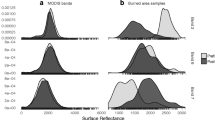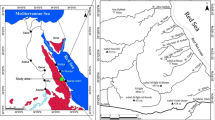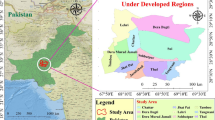Abstract
A selective variance reduction methodology is presented that reduces the band-to-band correlation observed in Landsat ETM imagery allowing a thematic-based de-correlation stretch. The bands 1 to 5, and band 7 are transformed to principal components (PCs). PC-1 and PC-2 account for the 94.7% of the total variance evident in images. In the current case study, band 3 and band 4 are selected to predict PC-1 and PC-2, respectively, through linear regression models. The PC-1 and PC-2 predicted image accounts for the 94.3% and 91.1%, respectively, of the total variance evident in the regression models. The bands 1 to 5 and 7 images are reconstructed from the two PC-1 and PC-2 residual images as well as PC-3 to PC-6 images. Thus, a thematic-based (band-dependent) decorrelation stretch of ETM imagery is achieved allowing the elimination of variance components that are related to spectral signature similarity of landcover types evident in Central Valley (California). The reconstructed imagery, a new higher order Landsat product, will assist image analysis, photo-interpretation, agricultural terrain analysis, mapping applications, and environmental monitoring at global level.










Similar content being viewed by others
References
Tatem A, Nayar A, Hay S (2006) Scene selection and the use of NASA’s global orthorectified Landsat dataset for land cover and land use change monitoring. Int J Remote Sens 27:3073–3078. https://doi.org/10.1080/01431160600589195
Roy D, Wulder M, Loveland T et al (2014) Landsat-8: science and product vision for terrestrial global change research. Remote Sens Environ 145:154–172. https://doi.org/10.1016/j.rse.2014.02.001
Markham B, Barker J (1985) Spectral characterization of the LANDSAT thematic mapper sensors. Int J Remote Sens 6:697–716. https://doi.org/10.1080/01431168508948492
Goward S, Arvidson T, Williams D, Faundeen J, Irons J, Franks S (2006) Historical record of Landsat global coverage. Photogramm Eng Remote Sens 72:1155–1169. https://doi.org/10.14358/PERS.72.10.1155
Kovalsky V, Roy D (2013) The global availability of Landsat 5 TM and Landsat 7 ETM+ land surface observations and implications for global 30m Landsat data product generation. Remote Sens Environ 130:280–293. https://doi.org/10.1016/j.rse.2012.12.003
Sonobe R, Yamaya Y, Tani H, Wang X, Kobayashi N, Mochizuki K (2017) Mapping crop cover using multi-temporal Landsat 8 OLI imagery. Int J Remote Sens 38:4348–4361. https://doi.org/10.1080/01431161.2017.1323286
Gill T, Johansen K, Phinn S, Trevithick R, Scarth P, Armston J (2017) A method for mapping Australian woody vegetation cover by linking continental-scale field data and long-term Landsat time series. Int J Remote Sens 38:679–705. https://doi.org/10.1080/01431161.2016.1266112
Wang Z, Tyo J, Hayat M (2007) Data interpretation for spectral sensors with correlated bands. J Opt Soc Am A Opt Image Sci Vis 24:2864–2870. https://doi.org/10.1364/JOSAA.24.002864
Lillesand T, Kiefer R, Chipman J (2008) Remote sensing and image interpretation. Wiley, New York
ETM (2017) Landsat enhanced thematic mapper plus spectral resolution. U.S.G.S., Available online at: https://www.usgs.gov/faqs/what-are-best-landsat-spectral-bands-use-my-study? (accessed 15 Sept 2018)
Mather P, Koch M (2011) Computer processing of remotely-sensed images, 4th edn. John Wiley & Sons, Chichester
Landam S, Everitt B (2004) A handbook for statistical analyses using SPSS. Chapman and Hall/CRC Press, New York
Miliaresis G (2012) Elevation, latitude and longitude decorrelation stretch of multi-temporal near-diurnal LST imagery. Int J Remote Sens 33:6020–6034. https://doi.org/10.1080/01431161.2012.676690
Miliaresis G (2013) Terrain analysis for active tectonic zone characterization, a new application for MODIS night LST (MYD11C3) dataset. Int J Geogr Inf Sci 27:1417–1432. https://doi.org/10.1080/13658816.2012.685172
Miliaresis G (2016) Spatial decorrelation stretch of annual (2003-2014) Daymet precipitation summaries on a 1-km grid for California, Nevada, Arizona and Utah. Environ Monit Assess 188. https://doi.org/10.1007/s10661-016-5365-5
Miliaresis G (2017) Iterative selective spatial variance reduction of MYD11A2 LST data. Earth Sci Inf 10:15–27. https://doi.org/10.1007/s12145-016-0271-5
Miliaresis G (2017) Selective variance reduction (SVR). GitHub Project. Available online at: https://github.com/miliaresis/SVR, (accessed 15 Sept 2018)
Miliaresis G (2014) Daily temperature oscillation enhancement of multi-temporal LST imagery. Photogramm Eng Remote Sens 80:423–428. https://doi.org/10.14358/PERS.80.5.423
Soulard C, Wilson T (2015) Recent land-use/land-cover change in the Central California Valley. J Land Use Sci 10:59–80. https://doi.org/10.1080/1747423X.2013.841297
CALCC (2015) Land cover and agriculture in California’s Central Valley. California Landscape Conservation Cooperative. Available online at: https://databasin.org/maps/38efc8f062e94305b32839fe8f88ab14 (accessed 15 Sept 2018)
Slater J, Garvey G, Johnston C, Haase J, Heady B, Kroenung G, Little J (2006) The SRTM data “finishing” process and products. Photogramm Eng Remote Sens 72:237–247. https://doi.org/10.14358/PERS.72.3.237
Author information
Authors and Affiliations
Corresponding author
Additional information
Publisher’s Note
Springer Nature remains neutral with regard to jurisdictional claims in published maps and institutional affiliations.
Rights and permissions
About this article
Cite this article
Miliaresis, G.C. Selective Thematic Information Content Enhancement of LANDSAT ETM Imagery. Remote Sens Earth Syst Sci 1, 53–62 (2018). https://doi.org/10.1007/s41976-018-0005-1
Received:
Revised:
Accepted:
Published:
Issue Date:
DOI: https://doi.org/10.1007/s41976-018-0005-1




